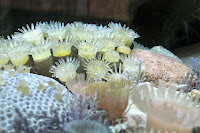When we
think of natural history, we tend to imagine fossils and fish, animals with
ferocious teeth or giant claws, old bones and shark teeth. I think of Rusty and
his friends – the mastodon, the woolly mammoth – and the Devonian section.
 But
natural history is more than just the history of extinct animals – it’s a way
to catalogue our world, even as it changes.
At the tail end of the Iowa Hall gallery – past the prehistoric fish,
the swampy jungle, and Rusty himself – you’ll find a diorama of a Meskwaki
settlement, circa 1850, or right after Iowa became a state. It’s an important marker of Iowa’s past, and
filled with interesting artifacts to explore.
But
natural history is more than just the history of extinct animals – it’s a way
to catalogue our world, even as it changes.
At the tail end of the Iowa Hall gallery – past the prehistoric fish,
the swampy jungle, and Rusty himself – you’ll find a diorama of a Meskwaki
settlement, circa 1850, or right after Iowa became a state. It’s an important marker of Iowa’s past, and
filled with interesting artifacts to explore.
In the
main diorama, an old man teaches a young boy how to carve wood – they sit
inside a winter lodge, which the Meskwaki built every winter, using a wooden
frame and a covering made of dried cattails.
Nearby, a woman makes a dye (although it looks like she’s cooking). Her cotton dress, and the wool blanket inside
the lodge, point to ongoing trade with settlers – after the first forays of
Marquette and Joliet, the first explorers to set foot on Iowa soil, trade among
Native Americans and settlers was inevitable.
Yet I
find the more interesting artifacts in the nearby cases. Beaded artwork abounds – the beads were
obtained via trading, but the artwork itself is entirely Meskwaki. Bows and arrows – even toy arrows for young
boys to practice with – and children’s toys cover the bottom of the gallery.
And perhaps the most interesting artifact is the necklace made of bear claws
and fur. Only worn by tribal leaders,
the bear claw necklace is made from twenty to thirty bear claws, but the claws
have to come from a specific paw, so that each bear claw necklace comes from
four or five bears.
It’s easy
to get distracted by Rusty and Dunky, the vast dioramas that seem to take us to
another time – sometimes, the Meskwaki exhibit seems like yesterday in
comparison. But what happened yesterday is just as important as what happened
last week, or three weeks ago, or three million weeks ago. Iowa’s history is
both prehistoric and historic – made up of both the fossils and geodes we
unearth from the soil, and the people who came to live here before us, who left
traces of their life behind, so we might someday know about who walked in our
footsteps. Shells and arrowheads,
projectile points and milling stones: just as fossils and bones tell us about
the animals who prowled around, so too do these artifacts.
After
all, we weren’t the first ones to set up shop in Iowa. Who wouldn’t want to
know about those who came before? That’s what the museum is for.
-Written by MNH Volunteer Catherine Babikian
-Written by MNH Volunteer Catherine Babikian






